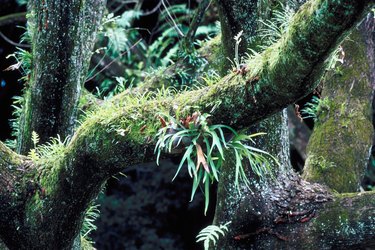
Not all plants can survive in all environments. For example, tropical plants will die in arid deserts. Adaptation is how one or more plant features may increase a species' ability to survive in a specific environment. The staghorn fern (Platycerium bifurcatum) adapts to living on trees in its native jungle habitat with unusual fronds that don't look like the fronds of other ferns and aerial roots that grow nowhere near soil.
Foliar Fronds
Video of the Day
Distinctive among ferns, staghorn has two types of leaves, or fronds: foliar and basal. The species name, bifurcatum, and the common name, staghorn, hint at the appearance of its foliar fronds. The fronds resemble deer antlers -- stag horns -- that are forked into two branches -- bifurcatum. Because ferns are flowerless plants that do not produce seeds, they must rely on the reproductive adaptation of producing spores. A staghorn's foliar fronds are also called fertile fronds, because they are the ones that produce and bear the spores. These foliar fronds also perform photosynthesis, which makes food for the plant.
Video of the Day
Basal Fronds
Basal fronds do not look like leaves, even though that's what they are. They are round, dish- or shield-shaped structures that are green when immature, but turn brown and papery with age. Basal fronds are also called infertile or sterile fronds because they do not produce or bear spores, the reproductive structures. Instead, they are adapted to attach staghorn ferns to the trees on which they grow and to collect water and nutrients that wash down the tree trunks. Basal fronds trap dead leaves and insects between their cup-shaped structures and tree trunks. They also cover and protect the roots, which absorb the trapped rainwater and decomposed nutrients.
Stellate Hairs
If you look closely at staghorn fronds, you see tiny silvery-white stellate, or star-shaped, hairs that look like a soft, felt covering. It's important not to wipe them off, mistaking them for a buildup of dust or a chemical residue. Instead, they are an important adaptation and removing them may compromise staghorn's health. Their purpose is twofold: They help retain moisture, and they may protect the fronds against insect attack. Staghorn ferns that grow indoors benefit from daily misting, -- the droplets adhere to the hairs and increase the humidity around the plants.
Roots
Staghorn fern grows as a perennial in U.S. Department of Agriculture plant hardiness zones 9 through 12. As an epiphyte, staghorn fern grows with its roots attached to tree trunks and branches, but the roots do not penetrate the bark and the plant does not feed off its tree host. Although the roots never make contact with the soil, they are adapted to growing above ground by being covered by the basal fronds. This protective cover shields the roots from the sun and keeps the roots moist.
- Missouri Botanical Garden: Platycerium Bifurcatum
- Conservatory of Flowers, Golden Gate Park San Francisco: Plant Adaptations
- University of Florida IFAS Extension: Staghorn Ferns at a Glance
- Texas A&M AgriLife Extension Service: Staghorn Fern
- Union County College: Staghorn Ferns
- University of Arkansas Cooperative Extension Service: Plant of the Week: Staghorn Fern